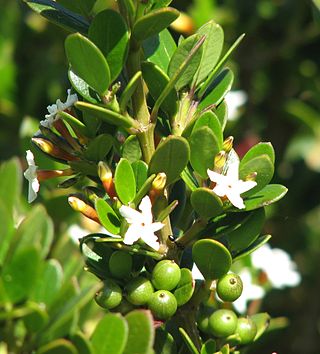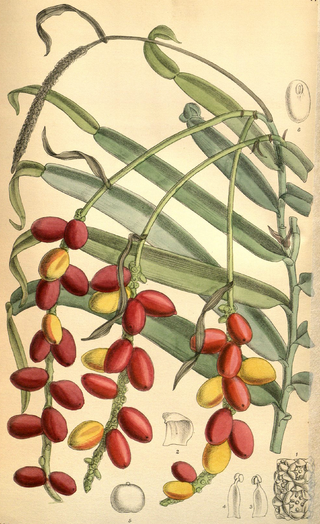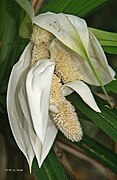
Alyxia is an Australasian genus of flowering plant in the dogbane family, Apocynaceae. It contains at present 106 species, but Alyxia stellata and A. tisserantii are very variable, might be cryptic species complexes, and are need of further study. It consists of shrubby, climbing or scrambling plants. This genus occurs in China, the Himalayas, Southeast Asia, Australia, New Caledonia and the Pacific Islands. There are 14 species in Australia, 21 in New Caledonia and 7 in the other Pacific Islands, including Hawaiʻi.

Pandanus is a genus of monocots with some 578 accepted species. They are palm-like, dioecious trees and shrubs native to the Old World tropics and subtropics. The greatest number of species are found in Madagascar and Malaysia. Common names include pandan, screw palm and screw pine. They are classified in the order Pandanales, family Pandanaceae.

Elaeocarpus is a genus of nearly five hundred species of flowering plants in the family Elaeocarpaceae native to the Western Indian Ocean, Tropical and Subtropical Asia, and the Pacific. Plants in the genus Elaeocarpus are trees or shrubs with simple leaves, flowers with four or five petals usually, and usually blue fruit.

Daemonorops was a genus of rattan palms in the family Arecaceae. Its species are now included within the genus Calamus. Species now placed in Daemonorops are dioecious, with male and female flowers on separate individuals. They are found primarily in the tropics and subtropics of southeastern Asia with a few species extending into southern China and the Himalayas.

Chionanthus, common name: fringetrees, is a genus of about 140 species of flowering plants in the family Oleaceae.

Pothos is a genus of flowering plants in the family Araceae. It is native to China, the Indian Subcontinent, Australia, New Guinea, Southeast Asia, and various islands of the Pacific and Indian Oceans.

Barringtonia is a genus of flowering plants in the family Lecythidaceae first described as a genus with this name in 1775. It is native to Africa, southern Asia, Australia, and various islands of the Pacific and Indian Oceans. The genus name commemorates Daines Barrington.

Goniothalamus is one of the largest palaeotropical genera of plant in family Annonaceae.

Ryparosa is a genus of plants in the family Achariaceae.

Martellidendron is a genus of flowering plants in the family Pandanaceae, native to the Seychelles and Madagascar. They resemble palms, but are not closely related to palms. The genus Martellidendron, was previously recognized as a section of the genus Pandanus in 1951 by Rodolfo Emilio Giuseppe Pichi-Sermolli, Then as a subgenus in 1974. It was finally separated out in 2003 on the basis of phylogenetic studies that used chloroplast DNA sequence data.

Amischotolype is a genus of perennial monocotyledonous flowering plants in the Commelinaceae. It is found in Central Africa and from India through Southeast Asia to New Guinea, with the great majority or species found in Asia.

Phrynium is a genus of flowering plants native to China, India, Southeast Asia, New Guinea and Melanesia. It was described as a genus in 1797.

Boesenbergia is a genus of plants in the ginger family. It contains more than 90 species, native to China, the Indian Subcontinent, and Southeast Asia.

Callicarpa (beautyberry) is a genus of shrubs and small trees in the family Lamiaceae. They are native to east and southeast Asia, Australia, Madagascar, southeast North America and South America.
Teijsmanniodendron is a genus of flowering plants in the mint family, Lamiaceae, first described in 1904. It is native to Southeast Asia and Papuasia.
Pandanus calcicola a species of plant in the family Pandanaceae. It is native to Peninsular Malaysia. Its stems are about one meter tall, while the thick, leathery leaves can be up to 4 meters long. The leaves are slightly paler on the underside and feature reticulate venation. Terminal, spike inflorescences with long peduncles give way to drupes.

Benstonea monticola, commonly known as scrub breadfruit or urchin-fruited pandan, is a plant in the family Pandanaceae which is endemic to rainforested parts of north east Queensland, Australia.

Benstonea lauterbachii, commonly known as Lauterbach's pandan, is a shrub or small tree to 15 m (49 ft) in the family Pandanaceae endemic to Cape York Peninsula in Queensland, Australia. It was first described as Pandanus lauterbachii in 1900, but was revised in 2012 by Martin Callmander and Sven Buerki who placed it in the newly created genus Benstonea. In Australia it is found from the tip of Cape York to Iron Range, with an isolated occurrence at the Hull River near Tully.





















